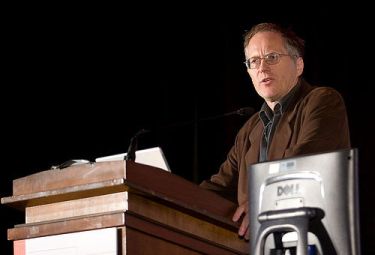O'Reilly: Web 2.0 to be built on the backs of hackers

Updated 12:10 PM 7/1/05. Tim O'Reilly spoke today at Where 2.0 about the merits of holding a confab focused on mapping and location based technologies and framed it in the context of the emergence of a new platform, Web 2.0. O'Reilly said that the mapping industry is at an inflection point as evidenced by the flurry of recent company announcements and, more importantly, from watching increased activity among the "alpha geek" community. He claimed to have been among the first to predict the emergence of Web services in the late 90s from watching the rise of screen scraping. Similarly, he saw universal Wi-Fi on the horizon when hackers in the wireless community started extending signal range with empty Pringles cans.
According to O'Reilly, the new killer apps are all using open source software, pointing to the biggest brands on the Internet like Google and Yahoo. From this he sees the Web 2.0 platform emerging and taking the shape of small pieces loosely joined. "It has no central control point, just rules for interoperability," he said. He described it by saying that it’ll be designed so that "independent actors" can easily extend it with low barriers to experimentation. Also key to the platform is that interoperable components can be easily switched out if better one comes along, said O'Reilly.

Tim O’Reilly speaking at Where 2.0. (Photo: James Duncan Davidson/O'Reilly Media)
O’Reilly then connected the dots back to mapping. First he quoted someone who once said "Windows is just a bag of drivers." "With the Win32 API, it meant that developers didn’t have to write their own device drivers," he said. "The 'data Web' is the next bag of drivers for Web 2.0." When looking at which questions websites aim to answer (i.e. "what"= eBay, Amazon; "who"=Passport, 1-Click; "how"=Google) the "where" piece is one of the most exciting areas according to O'Reilly. "Where 2.0 is the subsystem to the Web 2.0 operating system…Web 2.0 will be built from a network of cooperating data services.”(Update: Ross Mayfield writes about the Who, What, When, Where, and Why of the Web.)
"ESRI, MapQuest, and Microsoft MapPoint offered Web services APIs with lots of usage...but they are not hacker friendly," he said.
"Google maps with Craigslist is the first true Web 2.0 application, neither of the sites was involved...a developer put it together," he said. "Hackers are teaching the industry what to do."
To get to the next stage he offered these core rules to the audience:
- Users add value: more tools for easy user geo annotation and linking
- Network effects by default: auto geodata capture in devices
- Small pieces loosely joined: syndicated business model
- Software above the level of a single device: think beyond the PC
- Data is the next Intel Inside: Room to let the innovation run without a business model